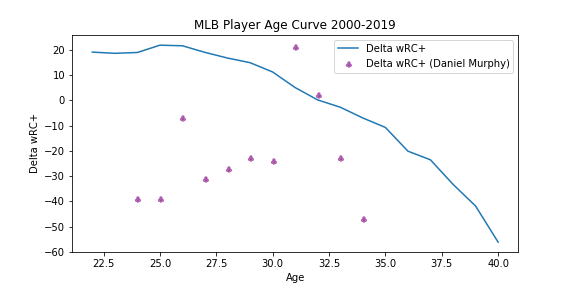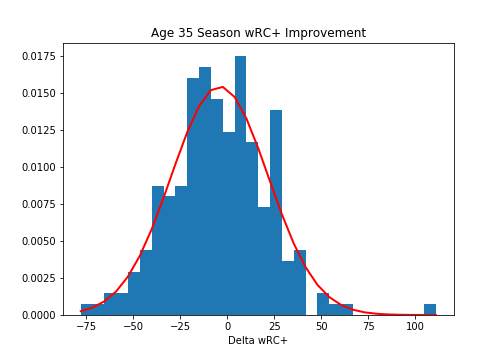The effect that age has on one’s ability to perform as a professional baseball hitter is well documented, which is why high dollar contracts for aging players come under so much criticism. The Rockies’ most recent challenge to this is the 2019 signing of Daniel Murphy in lieu of retaining clubhouse favorite and perennial Gold Glove contending DJ LeMahieu. Year 1 of this experiment did not work out, but let’s take a look at what the historical age curve tells us.
Delta Method
Throughout this post, the focus is on the change in hitting performance from one season to the next. The metric of choice for our analysis will be weighted runs created plus (wRC+) - a measure that rates a player’s performance in relation to other players in the league taking into account park effects and other variables. A wRC+ value of 100 is average with values above 100 for performance better than average and values below 100 for performance lower than average. A detailed breakdown of wRC+ can be found at https://library.fangraphs.com/offense/wrc/.
Age curves are generated using the difference between wRC+ from one season and the previous season. Values are valid only if the player had at least 150 plate appearances in both seasons. Previous age curve studies have used harmonic mean to weight for volume (i.e. plate appearances for each season), which is the method that has been applied here.
Age Curve 2000 - 2020
The age curve presented below shows the cumulative delta wRC+ for MLB players as a function of age. We see the total peaks at Age 27 and then falls off gradually afterwards. Daniel Murphy’s career trajectory is plotted here as well to see his career numbers compared to average. His peak season wRC+ value of 154 occurs during his Age 31 season, however, each of the three following seasons have seen his wRC+ drop by at least 19 points outpacing average decline. Another season of ~20 point drop in wRC+ would be devastating as it would most definitely result in a Josh Fuentes or AAAA type player taking over (at least you could expect something like that).
 Murphy’s age curve appears to have a much sharper decline than the historical average suggests, but it’s quite possible that he could reverse his fortune. We’ll next take a look at the Age 35 season and the possible outcomes for the Rockies’ 1B.
Murphy’s age curve appears to have a much sharper decline than the historical average suggests, but it’s quite possible that he could reverse his fortune. We’ll next take a look at the Age 35 season and the possible outcomes for the Rockies’ 1B.
Predicting Age 35 Season Value
Entering one’s age 35 season, the average MLB hitter over the last two decades experiences a 4 point decrease in wRC+. Of course, age is not the only factor, but it has an undeniable effect on a player’s hitting performance. Optimistic Rockies fans will point to Murphy’s finger injury (he broke his finger 2 games into the 2019 season) that hampered him all season long and claim that he’s due for a bounce back season. This is a valid point and perhaps gives us some insight in a qualitative way (I will not attempt to analyze the effect of a finger injury on a player’s performance in this post). To further shed some light on Daniel Murphy’s 2020 outlook we’ll look at the Age 35 season history and pull some comps that might demonstrate precedence for optimism.
Delta wRC+ Distribution
The statistical distribution resembles a normal distribution curve with a mean of -4 and a standard deviation of 26. Thus approximately two-thirds of sluggers entering his Age 35 season will gain between -30 and 22 wRC+. This represents the likely range of outcomes for Murphy in 2020 which would ends up being an expected wRC+ between 56 and 108. Admittedly, it’s a pretty wide range, but understanding this is important because while it’s not impossible for him to bounce back in a big way, it’s quite unlikely he’ll eclipse a wRC+ of 110.

Player Comps
There are 218 players in our Age 35 bucket. If we look at player seasons that more closely resemble Murphy’s profile, there is evidence to suggest a more optimistic range of output. Jim Thome, bounced back from a sub-par 2005 to boost his wRC+ by 60 points in his age 35 season. Similar to Murphy, his age 34 including an injury and career low wRC+. However, unlike Murphy, he’s a HOF home run hitter and slugged 42 home runs at age 35. I’m fairly certain that will not happen for Daniel Murphy. A better comp, might be AJ Pierzynski, who in 2012 saw an increase of 27 wRC+ from his age 34 season. It’s good news to have some precedence that shows while statistically improbable, there are case examples that give us hope.
What is more encouraging, however, is that the mean of this group is a gain of 4.4 and range of outcomes for Murphy of 68 to 113.
Contract Worthy?
Looking back, Rockies fans, the Front Office, and I’m sure Daniel Murphy himself would all agree that 2019 was a season to forget and we can look forward to a 2020 that will paint a different picture. The rule of thumb these days is that each WAR earned by a player equates to about $8M in annual salary, which for Murphy ($12M in 2020) to achieve this season would set the bar at around 1.5 WAR. At 1B, his wRC+ would need to be in the neighborhood of 110, assuming marginal impact from baserunning and defense and 500 PA) and a gain of 24 from last season which represents the high end of performance based on our analysis.
I feel more comfortable pegging him for a slight increase of say 5 - 10 points on his wRC+, let’s call it a wRC+ of 95 for 2020. I hope I’m wrong! What say you Rockies fans?
